Oven-baked and shaped in a cylinder, Datemaki or Japanese Sweet Rolled Omelette is a must-have Osechi Ryori dish on New Year’s Day. Similar to tamagoyaki, this sweet-savory omelette is tender and moist inside with a golden brown exterior and sunny shape.
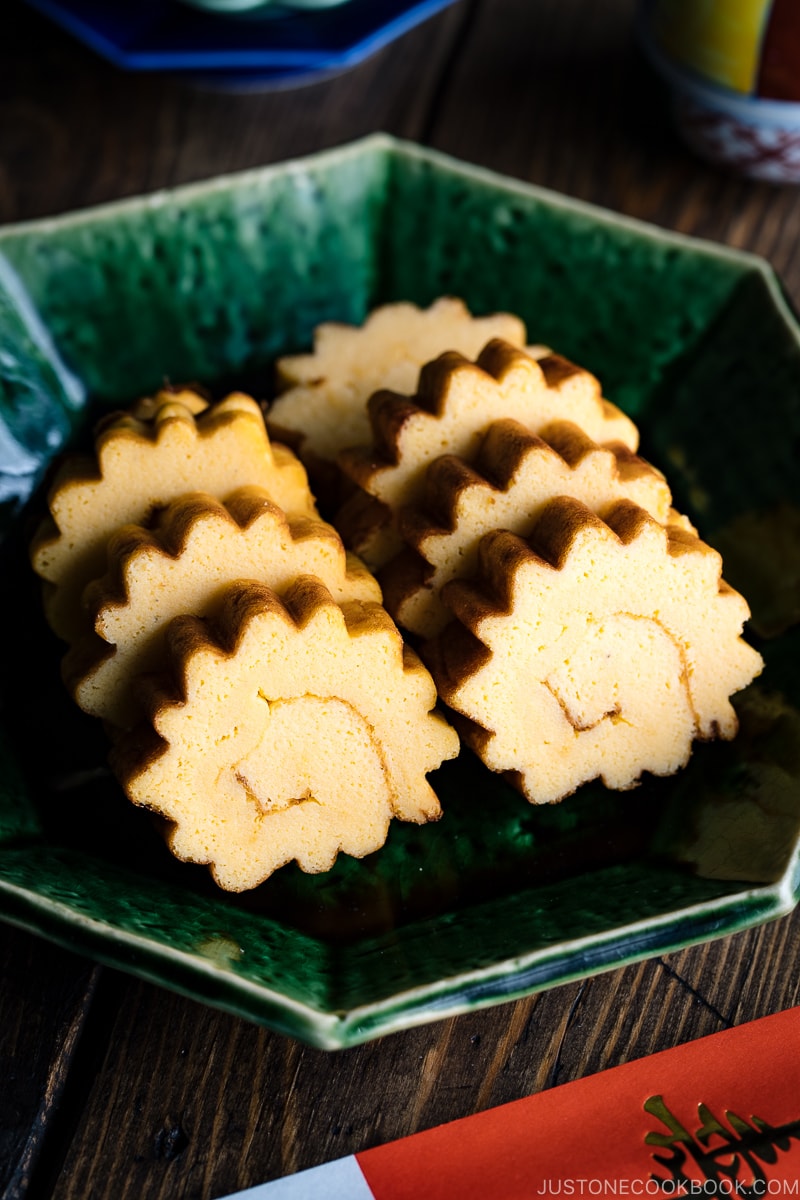
Datemaki (伊達巻) is a traditional sweet rolled omelette typically eaten as part of Japanese New Year’s food (osechi ryori, 御節料理). Served in a lacquered jubako (special square boxes similar to lunch boxes), it is made with eggs mixed with fish or shrimp paste and sweetened with sugar and mirin.
Among all the dishes for osechi ryori, datemaki often stands out for its bright sunny color and unique shape. It is by far my favorite dish among the new year foods and I always look forward to eating it every year. The sweet and savory flavor and almost cake-like texture make it a popular choice for the whole family!
You can often find pre-made datemaki being sold at Japanese grocery stores during this time of the year, but it is really easy to make it from scratch. I’ll show you how to achieve the perfect datemaki at home.
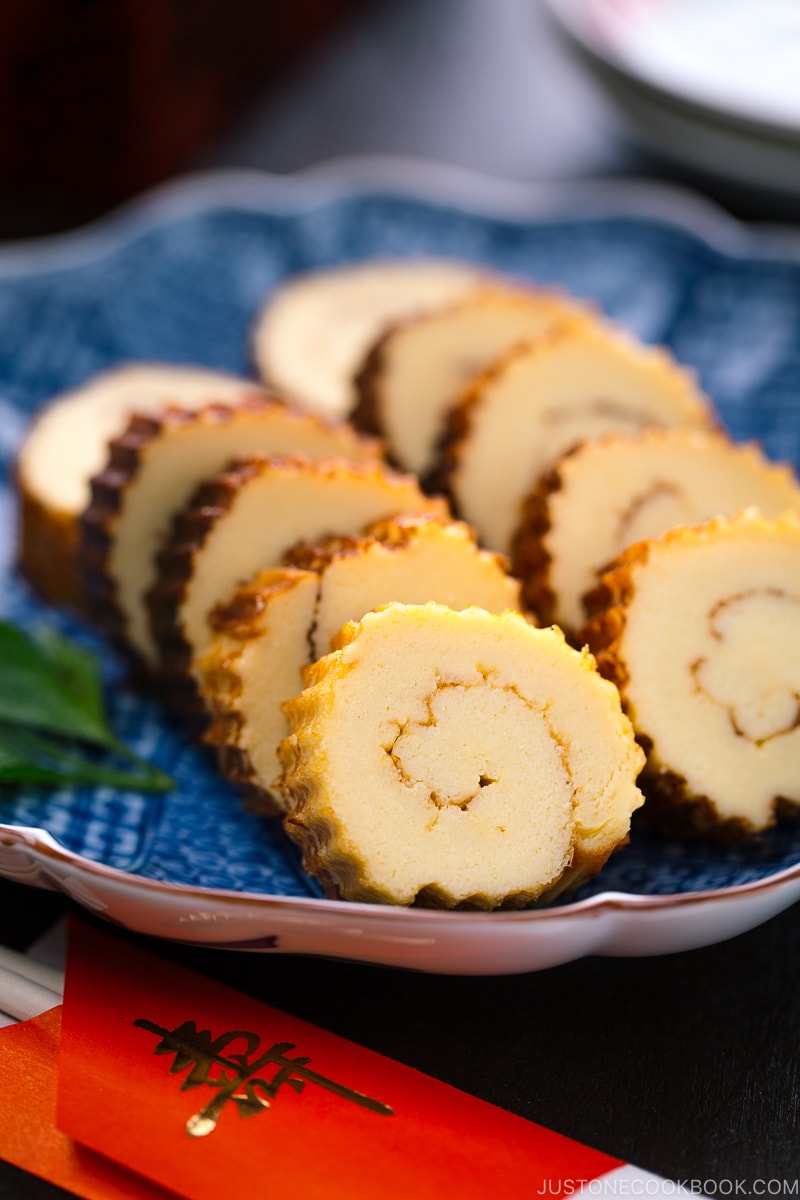
What is Datemaki
Datemaki is a must-have New Year’s food in Japan. It is similar to Tamagoyaki as both are rolled omelets with similar ingredients. The main difference is datemaki features a type of white fish cake called hanpen. Hanpen is made from grated Japanese yam (yamaimo) and surimi (Alaska Pollock), salt, and kombu dashi. It adds a unique flavor and a fluffy texture to the egg omelette, like a soft fish cake.
There are also other differences between datemaki and tamagoyaki:
- Instead of cooking on a pan over the stove, datemaki is baked in the oven in a single layer before being rolled into a cylinder and sliced. Just like baking a cake!
- Compared to tamagoyaki, datemaki is a little sweeter and is usually eaten only for the New Year.
The Symbolic Meaning of Datemaki
There are many different theories behind the symbolism of datemaki, but it is most commonly believed that eating datemaki will bring a good year of wisdom and learning, and success in studies (especially for student life). The rolled shape of datemaki is reminiscent of a scroll, which is historically a symbol of knowledge.
When I was a student, my mom would make sure that my brother and I had our good share of datemaki.
Another story was that the rolled fish cake omelet looked like a colorful kimono that fashionable people wore during the Edo period. As the word “date” refers to the sash for Japanese kimono and ‘maki’ means rolled, this is where the omelet got its name from.
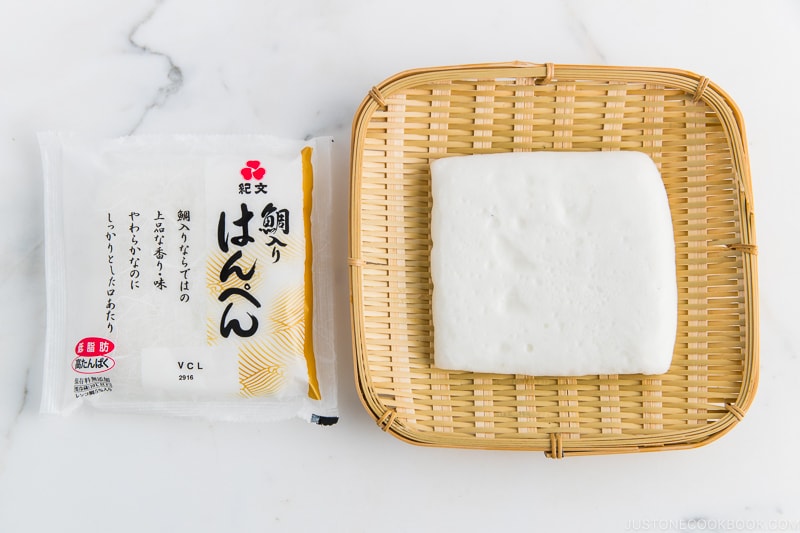
Ingredients You’ll Need to Make Datemaki
- Eggs
- Hanpen fish cake – You should be able to find hanpen in the freezer section at most Japanese grocery stores. Alternatively, you can substitute it with pureed white fish, scallops, or shrimp.
- Mirin
- Sake
- Sugar – Datemaki is meant to be sweet, but you can cut down the sugar slightly if you prefer.
- Honey
- Soy sauce
Many datemaki recipes require dashi, but I find it not necessary as hanpen is made of kombu dashi and it already adds a nice flavor to the omelette. Of course, you can always add dashi if you like.
After blending all the ingredients for the egg mixture, it is then baked until firm and nicely browned on the outside.
You have probably seen or used makisu (巻き簀), a bamboo mat, to roll sushi or stabilize the shape of Tamagoyaki. For the decorative purposes, we use this special bamboo mat called onisudare (鬼簾, 鬼すだれ) for datemaki. This rolling mat has deep notches that gives the signature zigzag marks on the surface of the omelet.
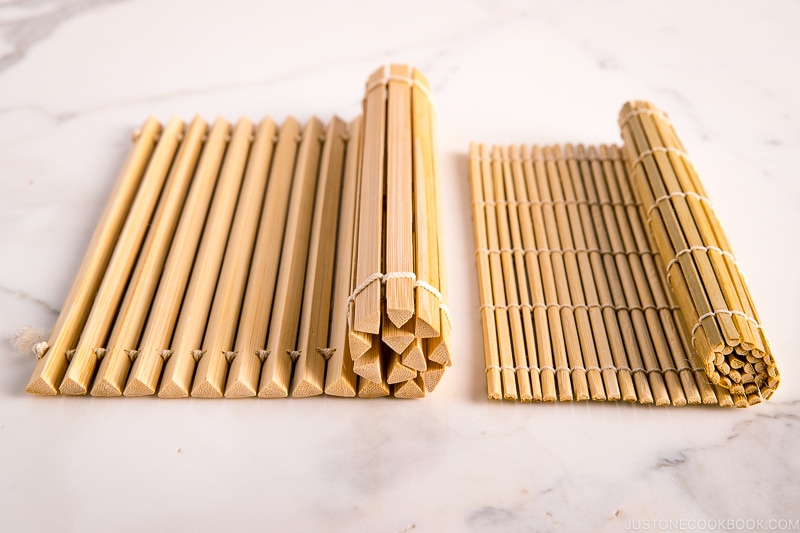
If you don’t have onisudare, you can still use a regular bamboo mat to give a similar effect to datemaki. The ridges are less striking but they still look pretty (see the right picture below).
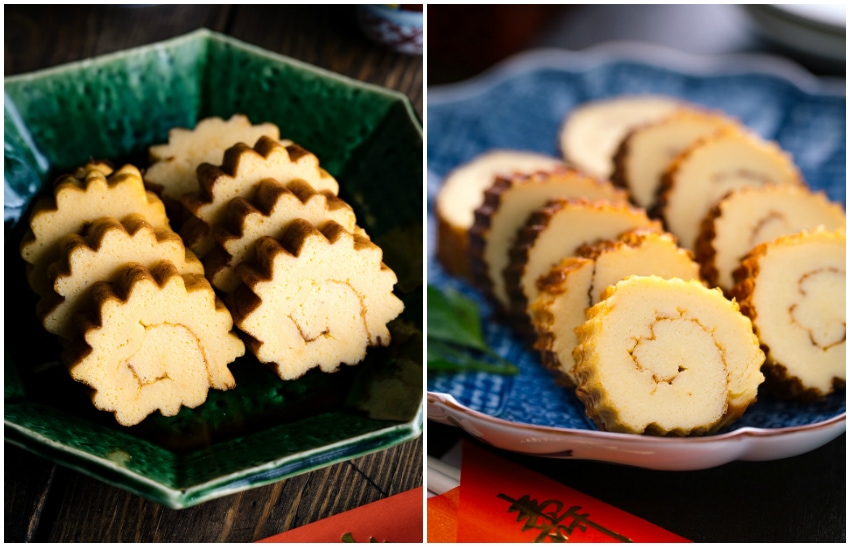
Quick Tips For Making Datemaki
- Strain the egg mixture through a fine sieve will yield a smooth, airy, and fluffy texture.
- The final texture of datemaki should be tender and moist in the middle and the top golden brown. Watch your oven toward the end of baking. If the top is not golden brown, switch to a broiler and broil for 2 minutes.
- Roll the omelette while it is still hot and gently score the omelet before you roll. This will help the omelette roll up easily without cracking.
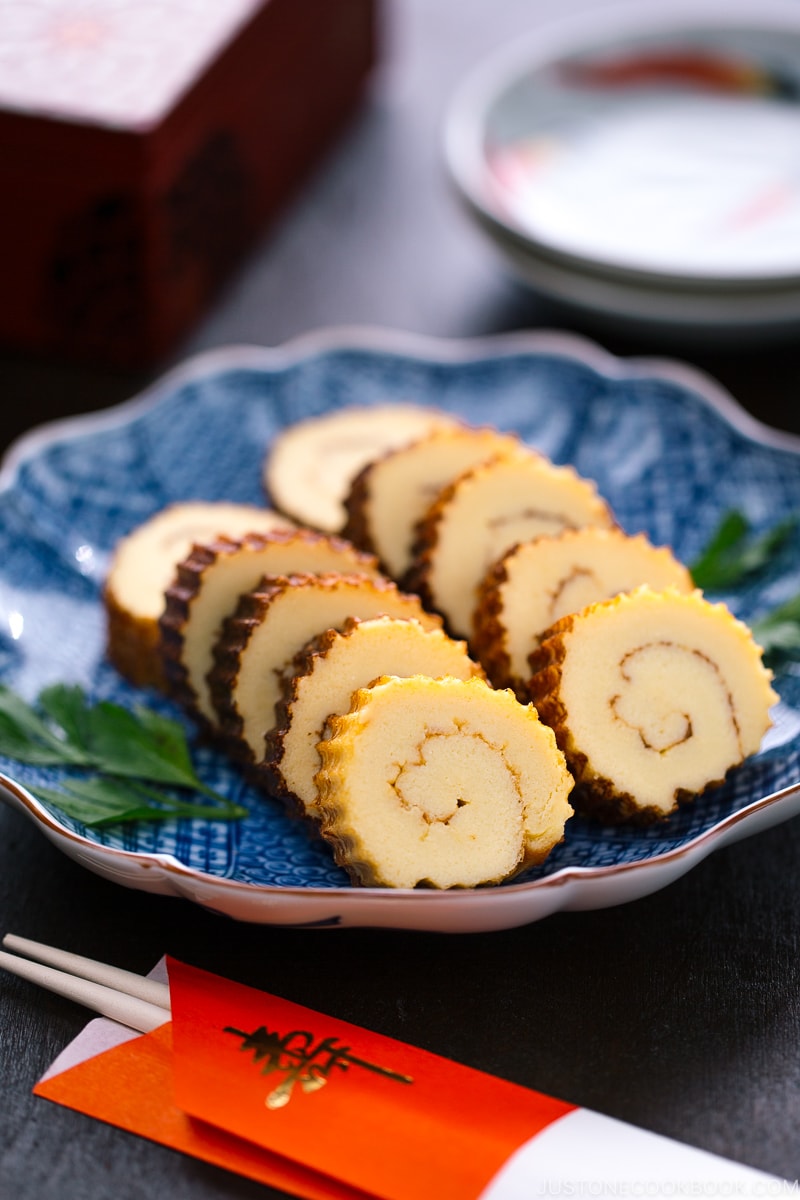
Perfect Make-Ahead Dish for Osechi
Datemaki is meant to be served at room temperature. Since it stores well in the refrigerator for 4-5 days, you can slice it and keep them in an airtight container or reusable plastic bag.
More Easy Japanese New Year Recipes
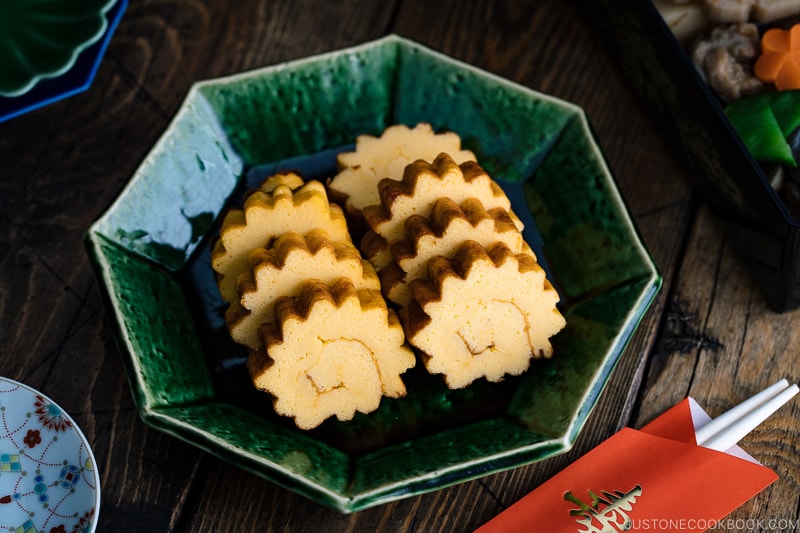
Wish to learn more about Japanese cooking? Sign up for our free newsletter to receive cooking tips & recipe updates! And stay in touch with me on Facebook, Pinterest, YouTube, and Instagram.
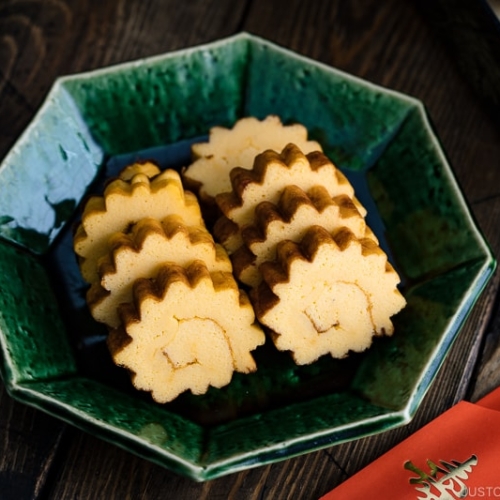
Datemaki (Sweet Rolled Omelette)
Oven-baked and shaped in a cylinder, Datemaki or Japanese Sweet Rolled Omelette is a must-have Osechi Ryori dish on New Year’s Day. Similar to tamagoyaki, this sweet-savory omelette is tender and moist inside with a golden brown exterior and sunny shape.
Ingredients
Prevent your screen from going dark
Instructions
-
Before You Start: If you will include this dish in your Osechi meal, I recommend cooking it 2 days before you plan to serve. For more helpful tips on planning your Japanese New Year feast, please read my A 5-Day Osechi Cooking Timeline blog post.
-
Gather all the ingredients. You will need parchment paper and a bamboo sushi mat. In Japan, we use a special bamboo mat with thicker strips called onisudare, which makes big ridges or indentations on the Datemaki.
-
Preheat the oven to 400ºF (200ºC). For a convection oven, reduce the cooking temperature by 25ºF (15ºC). Line an 8 x 8-inch (20 x 20-cm) baking dish with parchment paper.
To Prepare the Ingredients
-
Cut 1 package hanpen (fish cake) into ½-inch (1.3-cm) cubes. Next, whisk 4 large eggs (50 g each w/o shell) in a small bowl.
-
To a blender or food processor, add the hanpen and all the seasonings: 2 Tbsp mirin, 1 Tbsp sake, 1 Tbsp sugar, 1 tsp honey, and ½ tsp soy sauce.
-
Add the beaten egg and blend until smooth, about 1 to 1½ minutes.
-
Strain the egg mixture through a fine-mesh sieve into a clean bowl. You can use a spatula to help pass the mixture through the sieve.
-
Then, pour the mixture back into the blender jar and strain it one more time into the bowl. Finally, pour the strained mixture into the baking dish lined with parchment paper.
-
Bake at 400ºF (200ºC) for 20 minutes or until slightly brown on top. If the top is not golden brown, switch to the Broiler setting and broil for 2 minutes or until the surface is golden brown. The center of the omelette will rise slightly as the top gets brown. It will shrink as it cools.
To Roll the Datemaki
-
Remove the baking dish from the oven. Let the omelette deflate and rest until it’s just cool enough to handle, only for 1–2 minutes (DO NOT LEAVE IT LONGER than that). We will need to roll the omelette while it’s still hot.
-
Lift the omelette from the baking dish using the parchment paper and transfer it to a work surface. Then, place the bamboo mat over the omelette, with the flat side of the bamboo facing up.
-
Hold the omelette between the bamboo mat and the parchment paper. Then, carefully flip over the omelette onto the bamboo mat. Remove the parchment paper.
-
Now, score the omelette: Rotate the bamboo mat so the slats line up with the direction of your knife. Starting at one edge, use a knife to carefully score along the length of the omelette about ⅛ inch (3 mm) deep. Make sure the knife is parallel to the slats of the bamboo mat. Repeat, scoring the omelette lengthwise every ½ inch (1.3 cm) until you reach the other edge. Tip: These incisions will help the omelette roll up without breaking or cracking.
-
Use the bamboo mat to roll the omelette into a tight cylinder. Then, continue to roll the bamboo mat tightly around the omelette to help hold its cylinder shape.
-
Secure the bamboo and omelette roll with rubber bands so they hold the omelette cylinder firmly and tightly in place. Then, wrap it with plastic wrap. Let it cool completely for 2–3 hours.
Nutrition
Nutrition Facts
Datemaki (Sweet Rolled Omelette)
Amount per Serving
% Daily Value*
* Percent Daily Values are based on a 2000 calorie diet.
Editor’s Note: This post was originally published on Dec 26, 2013. The pictures have been updated in December 2019. The post has been republished on December 2023.


